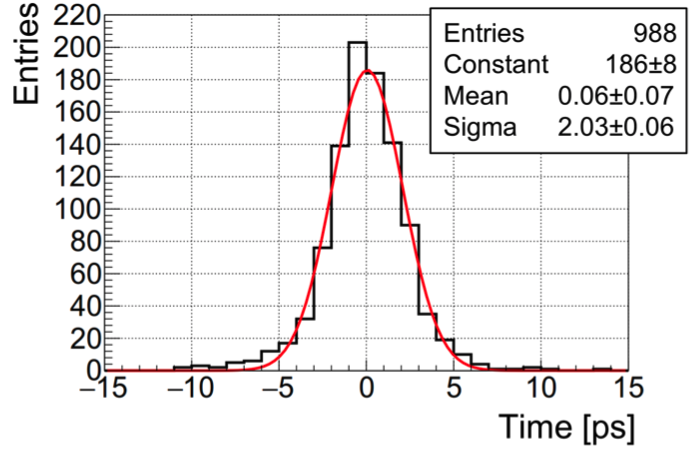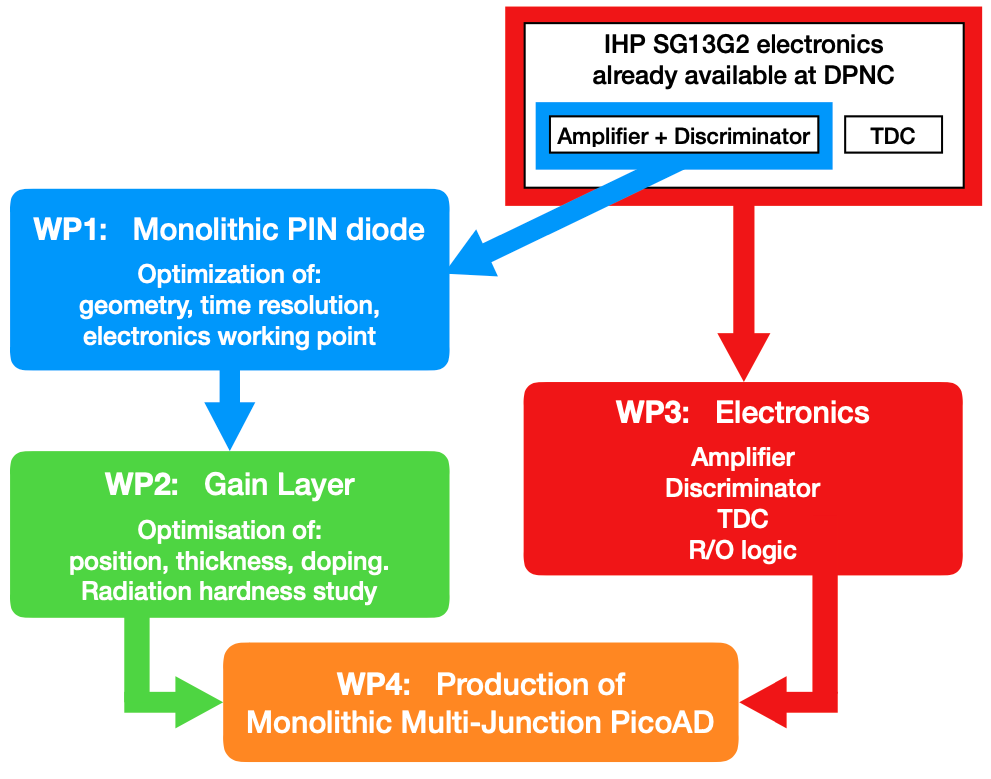Giuseppe Iacobucci Web Pages
The MONOLITH ERC Advanced Project

WHAT IS THE MONOLITH PROJECT PROPOSING ?
We want to develop a monolithic silicon sensor able to measure precisely the 3D spatial position of charged particles while providing at the same time picosecond time resolution. To provide future experiments with a sustainable solution, these goals will be achieved by the reduced production complexity and cost of monolithic sensors exploiting commercial CMOS processes of large-volume silicon foundries.
WHY ?
The outstanding time resolution and monolithic nature of the detector proposed by the MONOLITH project, combined with the high granularity, the low material budget and the reduced production complexity and cost with respect to hybrid silicon sensors, will represent a ground-breaking and sustainable instrument for basic research, in particular for:
- future high-energy physics experiments at colliders;
- rare-decay experiments featuring active targets or requiring precise tracking;
- space-borne astroparticle physics experiments and space science;
- nuclear-physics measurement of lifetimes of excited states in short-lived nuclei.
Besides the primary goal of basic science, it will represent an extraordinary enabling technology for the large spectrum of high-tech applications that benefits of picosecond-level Time-Of-Flight measurements. The innovative monolithic detector introduced here will also offer a starting point for further progress in the field of light detection.
HOW ?
The diode structure of present silicon pixel sensors strongly penalises the enormous potential of silicon-based time measurement. The MONOLITH project introduces a novel silicon-sensor structure devised to overcome the intrinsic limits of present sensors. This goal is achieved by the Picosecond Avalanche Detector (PicoAD), a novel sensor exploiting a fully depleted multi-PN junction (European Patent 18181123.3, 2 July 2018). The remarkable performance of the PicoAD, combined with the simplified assembly process and reduced production cost offered by the monolithic implementation in standard CMOS processes, represent the required breakthrough.

In addition to the multi-junction PicoAD sensor, the cornerstones of the project are the low-noise very-fast SiGe HBT frontend and the TDC with robust synchronisation method (patent EP 18 207 008.6, 19 November 2018) already produced in preliminary versions.
The MONOLITH project encompasses four work packages, as shown by the figure on the right.
We are presently developing our circuits and sensors using the IHP SG13G2 130nm process. Large-volume foundry processes will also be investigated.
European industrial partners have been contacted for commercial exploitation of the detector.
RESULTS so far:
- A proof-of-concept PicoAD prototype was produced by IHP. Wafers with epitaxial layers of 5µm (absorption region) and 10µm (drift region) were produced, with four different implant doses in between for the gain layer. Lab tests with 55Fe source showed that the detector works as expected, and provides a gain of 23 at HV=125V for the highest implant dose, see https://iopscience.iop.org/article/10.1088/1748-0221/17/10/P10032; the corresponding gain for minimum-ionizing particles is estimated to be 60-70.
- In testbeam measurements the proof-of-concept prototype proved full efficiency and and average time resolution of 17 ps, with 13 ps at the center of the pixel and 25 ps in the inter-pixel region https://iopscience.iop.org/article/10.1088/1748-0221/17/10/P10040.
- A second prototype was produced recently with several improvements in the electronics. Produced on a 50µm epilayer of resistivity of 350 Ωcm, WITHOUT INTERNAL GAIN LAYER, we obtained the following results:
- in a the testbeam: we obtained full efficiency and average time resolution of 20 ps, https://iopscience.iop.org/article/10.1088/1748-0221/18/03/P03047, which is a striking result for a PN-junction sensor without a gain layer
- using a 90Sr radioactive source: we proved that SiGe HBTs are radiation tolerant for proton fluence of 10^16 1 MeV n_eq/cm^2, with a timing performance of 40 ps, https://iopscience.iop.org/article/10.1088/1748-0221/19/01/P01014
- using a femtosecond laser, we measured time resolutions down to 3 ps https://arxiv.org/pdf/2401.01229.pdf
We are looking forward to early 2024 when a sensor will be produced based on these foundry masks and PicoAD wafers.

This MONOLITH research project is funded by the H2020 ERC Advanced grant 884447, July 2020 - June 2025

Participating researchers: Giuseppe Iacobucci, Lorenzo Paolozzi, Thanushan Kugathasan, Roberto Cardella, Stefano Zambito, Didier Ferrére, Yannick Favre, Stéphane Débieux, Matteo Milanesio, Théo Moretti, Antonio Picardi, Luca Iodice, Carlo Alberto Fenoglio, Andrea Pizarro-Medina, Ivan Semandyaev
Former participants: Magdalena Muenker, Pierpaolo Valerio, Fulvio Martinelli
Group publications on this subject:
-
Radiation Tolerance of SiGe BiCMOS Monolithic Silicon Pixel Detectors without Internal Gain Layer
M. MILANESIO et al.
Journal of Instrumentation 19 (P01014) (2023) [arXiv] -
20 ps Time Resolution with a Fully-Efficient Monolithic Silicon Pixel Detector without Internal Gain Layer
S. ZAMBITO et al.
JINST 18 (P03047) (2023) [arXiv]
-
Testbeam Results of the Picosecond Avalanche Detector Proof-Of-Concept Prototype
G. IACOBUCCI et al.
JINST 17 (P10040) (2022) [arXiv] -
Picosecond Avalanche Detector – working principle and gain measurement with a proof-of-concept prototype
L. PAOLOZZI et al.
JINST 17 (P10032) (2022) [arXiv] -
Efficiency and time resolution of monolithic silicon pixel detectors in SiGe BiCMOS technology
G. Iacobucci et al.
JINST P02019 (P02019) (2022) [arXiv]
-
Measurements and analysis of different front-end configurations for monolithic SiGe BiCMOS pixel detectors for HEP applications
F. MARTINELLI et al.
Journal of Instrumentation 16 (P12038) (2021) [arXiv] -
Monolithic Picosecond Silicon Pixel Sensors for Future Physics: Experiments and Applications
Giuseppe IACOBUCCI, Lorenzo PAOLOZZI, Pierpaolo VALERIO
IEEE Instrumentation & Measurement Magazine 24 (9) 5-11 (2021) -
A massively scalable Time-to-Digital Converter with a PLL-free calibration system in a commercial 130 nm process
F. MARTINELLI et al.
JINST 16 (P11023) (2021)
-
Time resolution and power consumption of a monolithic silicon pixel prototype in SiGe BiCMOS technology
L. PAOLOZZI et al.
JINST P11025 (P11025) (2020) [arXiv]
-
A 50 ps resolution monolithic active pixel sensor without internal gain in SiGe BiCMOS technology
Iacobucci G. et al.
JINST 14 (P11008) (2019) [arXiv]
-
A monolithic ASIC demonstrator for the Thin Time-of-Flight PET scanner
Valerio P. et al.
JINST 14 (P07013) (2018) [Other link] [arXiv] -
Characterization of the demonstrator of the fast silicon monolithic ASIC for the TT-PET project
Paolozzi L. et al.
JINST 14 (P02009) (2018) [Other link] [arXiv] -
Test beam measurement of the first prototype of the fast silicon pixel monolithic detector for the TT-PET project
L. PAOLOZZI et al.
JINST 13 (P04015) (2018) [arXiv]
